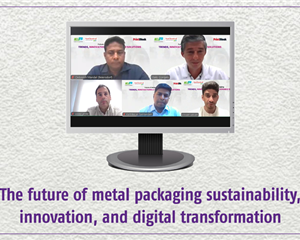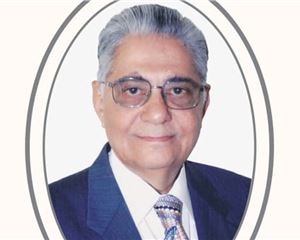Future of print in India is bright
A day after the inauguration of their new plant at Panoli in Gujarat, Rahul Kumar and Dibyajyoti Sarma of PrintWeek India have a tete a tete with Dr Kotaro Morita, president, Sakata Inx, and V K Seth, managing director, Sakata Inx India.
10 Sep 2014 | By Rahul Kumar & Dibyajyoti Sarma
PrintWeek India (PWI): Tell us about your web ink manufacturing plant at Panoli.
VK Seth (VKS): The facility will supplement the existing capacity of our Bhiwadi, Rajasthan plant.
PWI: What would be the capacity of the plant?
VKS: The capacity has not yet been established. However, it would be close to a capacity where, after DIC and Micro Ink, we would be the third largest in India in the segment.
PWI: How many newspaper houses do you supply ink to?
VKS: We have presence in all the large newspapers in India. Currently, we supply inks to close to 100 printing units. This doesn’t mean 100 newspapers, as one newspaper may have printing facilities at different locations. Though we do not have a large market share as compared to the other major players, we have presence with all the top names in the industry. We are waiting for our capacity to increase.
PWI: What is your market share in India?
VKS: It varies from segment to segment. To our estimates, our total market share in the organised market in liquid ink is at least 35-36%. By organised market, we mean MNC jobs like Coke, Pepsi, Nestle, Britannia, ITC, P&G or big converters with machines speeds running at 300 metres/min. Our offset share in sheetfed is 8-10% yet. With the new plant, we are taking a big leap into the web offset ink market.
PWI: Why web offset printing ink?
VKS: Sakata is the number one player in web ink in Japan. Outside the country, barring INX in the US, we did not have large capacity anywhere. This is the first time in India that we are facing giants like DIC and Flint, head on. We are confident that with the technology we have, and the new technology we have introduced, we will be able to take a substantial share in the Indian market.
PWI: For printing ink manufacturers, 2013 has been a fairly good year, with packaging, inkjet and UV continuing to be the highlights. Are these segments your growth areas as well and if yes, at what rate?
VKS: There are two parts to it – the Indian context and the international context. In Indian context, the segments you have mentioned have a bright future. We are closely monitoring the market.
PWI: Leading ink industry executives say there are growth areas in printing, such as packaging, digital and energy curing, while publication and commercial offset are struggling. Do comment.
VKS: I don’t think this is the case in India. If you believe in the Indian economy as I do, then, the GDP is likely to return to 7 to 8%. levels. The literacy rate in India is at 62%, which means 38% of the 1.3 billion people in the country are yet to pick up a book. Look at the potential. We talk about electronic gadgets. But when there isn’t enough electricity, how are you going to use these gadgets? I feel there will be growth for the next 20 years, if not more, equivalent to the growth rate of the GDP. If GDP grows at 7%, commercial printing or gravure will at least grow by 7%. The scenario from 2008 to now is a temporary hiccup.
PWI: India has been of the country with best growth rate for Sakata. Why so?
VKS: I think the key is the flexibility of the Sakata Japan management, in terms of the freedom given to us to do what is required for the market. Unlike many other Japanese companies, Sakata is open-minded to the requirements of a particular market and is willing to change.
PWI: Taking about decision-making, how Sakata India works differently from the parent company?
VKS: The heart of the technology is never touched. We market our branded products, like Lamiall, everywhere. However, some peripheral adjustments to suit machines, environments, and temperatures are done by us.
PWI: No ink company gives any kind of training related to printing or handling of ink…
VKS: We conduct specific programmes, four each year, in our Gurgaon headquarters. Some of them are very much in demand by our customers. In India, there is no formal platform for printers where they can upgrade their skills and knowledge. We have the database and we educate our customers. We talk about the four Ps of marketing. At Sakata, now, we say “SAVE”. S is for solution. We don’t sell our products, but offer solutions. A is availability. We are available with our products and people. V is for value. We don’t compete on price but offer value for our products and services. And, E is education. We educate our customers by sharing with them all possible developments and possibilities where our international experience comes vary handy.
PWI: Printers say that ink companies offer products which are price sensitive but never quality related. Is it a mindset that Indian printers are not ready for good quality print?
VKS: No. I feel quality expectations in India is highest in the world. Sometimes we don’t get the price we would like to get, but customer expectation is second to none.
PWI: When you ask for a higher price, what kind of reaction do you get from your customers?
VKS: They would say no. But we do get some premiums on all our products, across the table, because, we are consistent in our product performance, and that’s a very big need-gap in the market today.
PWI: For ink manufacturers, raw material supply and pricing were major concerns for the past few years. Are they a concern for Sakata?
VKS: In India, we are concerned. Prices are going up and availability is limited. We are always looking for new suppliers and vendors. Sometimes when they are not up to the mark, we help them develop their products.
KM: Earlier pigment manufacturers were in Japan and we could get the raw material in our country. Now, they are moving to China. So, we need to watch the supply globally.
PWI: Not really...
VKS: Sure, price is one of the important concerns for a newspaper house. So is consistency and print quality. This gives us an edge. Since the Indian newspaper industry is dependent on advertisement revenue, there is an effort by the newspaper companies to make the newspaper advertisement look like that of a magazine. This is a need gap we have identified. We should answer this more holistically by saying that the price-quality ratio is the best in India so the overall costs are probably higher in India if one were to compare it to the sales price.
PWI: More initiatives in India?
VKS: Of course. India is a big growth area and has lot of potential for us. We are closely watching. We are not a predator that we are looking for some hunt. No, but we know our strengths, and we know India is very exciting…
Kotaro Morita, Sakata Group President
PWI: What kind of growth do you see for Sakata in India?
Kotaro Morita (KM): Globally, we are into gravure and sheetfed ink. As the Indian market is growing, we expect more market from gravure. Packaging, another big market for us, is also on the rise.
PWI: The newspaper industry is in a downward trend…
KM: Not in India. Sakata was established as an ink company in Japan 118 years ago. Its origin lies in news ink. As you know, in Japan, like the US and Europe, with the rise in electronic media, the number of print publication is going down. But in India or China, because of more than one billion population and lower literacy rate, newspapers are still popular. Every day, total 100 million copies of newspapers are printed in India. This number is almost double compared to Japan. This is the reason we decided to invest in the Indian market in a big way.
PWI: For printing ink manufacturers, 2013 has been a fairly good year, with packaging, inkjet and UV continuing to be the highlights. Are these segments your growth areas as well and if yes, at what rate?
KM: Globally, we have the set-ups to develop UV, offset UV and flexo UV. We have the biggest market share in UV in the US and we started exporting it to Europe. When the sales went up, we decided to manufacture UV products in the UK and set up a plant in Manchester last year, especially for UV flexo products. In the UK, we also started manufacturing flexo ink.
PWI: India has been of the country with best growth rate for Sakata. Why so?
KM: We have been successful because we have good partners all over the world, especially in India, in terms of leadership and quality staff. Not only in India, we had good success rate in the US, and Indonesia too.
PWI: There is a perception that ink manufactures do not take effort in keeping up with the pollution norms as per country government policies. Again, disposal is a pain point…
KM: In Sakata, we are concentrating on this, especially in solid waste. We are doing a lot of Kaizen to limit generation of solid waste. When it is unavoidable, our R&D is looking at ways and means to turn them into useful products. If we cannot do anything about it, we dispose it off through authorised vendors of the pollution control board. We follow all the compliance norms. Our plants at Panoli and Bhiwadi are zero-discharge plants.
PWI: You have R&D centres in Japan, the US and India. How big is your R&D team?
KM: See, there are two types of R&Ds. One is basic R&D, which is done in Japan and the US. Sakata India, on the other hand, has been given a very large territory. We cover Africa, the CIS countries, Middle East and India. For Middle East, we will have to offer a different product, whereas in Africa, there are different machines. So, there are issues of raw material improvement. Also, India is so cost-competitive; our engineers have to experiment on new raw materials to maintain the cost without compromising on the quality. While these are the two basic functions of the Indian R&D team, comprising of 25 people, new product development is taken care of in Japan.
PWI: Is production cost cheaper in India, compared to, say Japan or the US?
KM: I would like to answer the question in a different way. If you see the price-quality ratio, the quality of the newspapers, the kind of print benchmarked by The Times of India or Hindustan Times, and the price expectations, I think India is very competitive. Does that answers your question?
PWI: There are more technological developments happening in digital, especially in inkjet, rather than in offset…
KM: It’s difficult to compare. But, of course, digital technology is growing. We acquired a digital company in 2006 in the US. In Sakata, we have an R&D for digital printing ink.
PWI: Any plans for digital ink in India?
KM: We are looking closely.
PWI: What new technologies are you developing?
KM: We have a team of 200 R&D researchers in Japan and 50 in the US. We have people in India too. They are working on something new every day, so it’s difficult to say what’s new. For example, for news ink at the Panoli plant, we are introducing a new technology called Luce inks. The ink was developed because of the demand from Japanese newspapers. They wanted vivid colours in their pages. It is a high colour-strength ink and if we increase colour strength, the price goes up.
PWI: For ink manufacturers, raw material supply and pricing were major concerns for the past few years. Are they a concern for Sakata?
KM: Earlier pigment manufacturers were in Japan and we could get the raw material in our country. Now, they are moving to China. So, we need to watch the supply globally.
PWI: Any plans of merger or acquisition in India?
KM: We acquired digital companies in 2006 and 2008, in the USA, Czech Republic and Italy. If a good opportunity comes our way, we will seriously consider it. We still have opportunities in South America and Africa, Middle East, and Eastern Europe. Demand is growing in these regions.
PWI: More initiatives in India?
KM: Exciting, yeah, and we expect growth in India. And have very good partners.
|
Secret to Sakata’s success in India
Explained VK Seth, managing director, Sakata India: “Right from the beginning, we have tried to enter into the Indian market in a systematic way. We have tried to identify the need-gap in a particular segment before we entered. For example, there was a big need-gap for technology of ink, which could run on high speed machines having low solvent retention, higher mileage, lower GSM and higher productivity. We identified it and this gave us the leverage. After discussions, market surveys and talking to newspapers big and small, we came to the conclusion that slowly, newspapers are upgrading from middle- to high-speed machines. Thus, productivity, efficiency and consistency became a major requirement and Sakata focused on it.” |
|
The sakata method in India
Headquartered in Japan, Sakata has business in the US, the UK, Europe and India and is looking to conquer the rest of the world. Talking about India, however, it has its own rules of engagement. So, how different is Sakata’s India market from the overseas markets? “Cultures are different,” said Kotaro Morita, president, Sakata Inx. “But basics of the inks are same. When we expand, our policy is to send a technical person first to study the needs of the country, as customers from each country have different demands.” V K Seth, managing director, Sakata India, added: “Price-quality ratio in each country is different, and each market has different needs. Sakata has a policy to tweak its products to suit the customer needs. We are flexible. We understand the market. We try to first understand what customers needs in any product segment before we venture in any new market.” |













 See All
See All